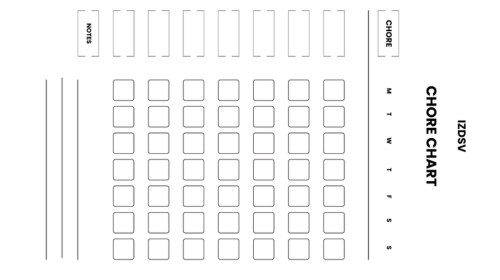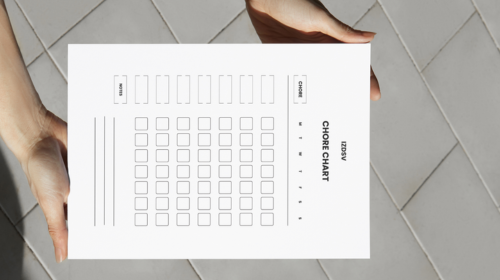Monthly Chore Chart for Multiple Kids: Simplify Chores
Benefits of Using a Chore Chart for Multiple Children
A chore chart provides clear structure and accountability for multiple children, making household responsibilities transparent and manageable for everyone involved. It eliminates confusion about who should do what and when, reducing sibling conflicts over fairness and expectations.
- Visual accountability – Children can see their assigned tasks and track their progress, creating a sense of ownership and accomplishment
- Fair distribution of work – Parents can ensure chores are divided equitably based on age, ability, and family needs
- Reduced nagging – The chart serves as a reminder system, allowing children to self-monitor without constant parental prompting
- Skill development tracking – Parents can gradually introduce more complex tasks as children demonstrate mastery of simpler ones
- Consistency maintenance – Regular routines become established, making household management more predictable for the entire family
- Independence building – Children learn to manage their time and responsibilities without constant supervision
Encouraging Responsibility Through Family Chores
Family chores teach children that they are contributing members of the household with meaningful roles to play in maintaining their shared living space. When children understand that their efforts directly impact the family’s daily functioning, they develop a stronger sense of personal responsibility and investment in their home environment.
- Age-appropriate task assignment – Starting with simple tasks like sorting socks and progressing to more complex responsibilities builds confidence and competence
- Natural consequence learning – Children experience firsthand how neglecting responsibilities affects themselves and others in the household
- Ownership mindset development – Regular chores help children see themselves as stakeholders in family life rather than passive recipients of care
- Time management skills – Balancing chores with other activities teaches children to prioritize and plan their daily schedules
- Problem-solving opportunities – Children learn to figure out efficient ways to complete tasks and overcome obstacles independently
- Pride in contribution – Completing meaningful work that benefits the family builds self-esteem and personal satisfaction
Building Teamwork Among Multiple Kids
Collaborative chores create opportunities for siblings to work together toward common goals, fostering cooperation and mutual support within the family unit. When children tackle larger projects as a team, they learn to communicate effectively, divide responsibilities, and appreciate each other’s unique strengths and contributions.
- Shared goal achievement – Working together on projects like cleaning the garage or organizing a playroom teaches children to coordinate their efforts
- Complementary skill utilization – Older children can mentor younger siblings while younger ones bring energy and fresh perspectives to tasks
- Communication skill development – Siblings learn to negotiate, delegate, and provide constructive feedback to accomplish shared objectives
- Conflict resolution practice – Working through disagreements during chore completion helps children develop important interpersonal skills
- Mutual support systems – Children learn to help each other when someone is struggling or falling behind on their responsibilities
- Celebration of collective success – Completing family projects together creates positive shared memories and reinforces the value of cooperation
How to Design a Printable Chore Chart for Multiple Kids
Creating an effective printable chore chart for multiple children requires careful consideration of layout, visual appeal, and functionality to accommodate different ages and abilities. The design should be clear enough for young children to understand while remaining organized enough to track multiple family members’ responsibilities efficiently.
- Multi-column layout – Create separate columns for each child’s name, with rows for different days of the week or specific chores
- Color-coding system – Assign each child a unique color to make their sections easily identifiable and personalized
- Age-appropriate symbols – Use pictures or icons alongside text for younger children who can’t read yet
- Progress tracking method – Include checkboxes, star stickers, or point systems to mark completed tasks
- Clear task descriptions – Write chores in simple, specific language that eliminates confusion about expectations
- Reward section – Add space for tracking earned privileges, allowance, or special activities based on completion
- Weekly reset capability – Design the chart so it can be easily updated or reprinted for ongoing use
- Size optimization – Format the chart to fit standard 8.5×11 paper while maintaining readability
Choosing the Right Template for Your Family
The most effective chore chart template matches your family’s specific needs, schedule, and the developmental stages of your children. Consider factors like the number of children, their ages, your family’s routine, and whether you prefer daily task management or weekly goal-setting when selecting a format.
- Daily grid format – Best for families with consistent routines who prefer checking off tasks each day
- Weekly overview style – Ideal for families with varying schedules who want to see the entire week at a glance
- Individual child charts – Separate charts for each child work well when siblings have very different ages and capabilities
- Family-wide chart – Single chart showing all family members encourages comparison and friendly competition
- Task rotation template – Charts that rotate chores among children prevent boredom and ensure everyone learns different skills
- Point-based system – Templates with numerical scoring work well for families who tie chores to allowance or rewards
- Simple checkbox design – Basic check-off lists suit families who prefer straightforward tracking without complex systems
- Customizable blank templates – Flexible formats allow you to adjust chores and layout as children grow and family needs change
Incorporating Daily and Weekly Chore Checklists
Combining daily and weekly chores in a single chart system helps children understand both routine maintenance tasks and larger periodic responsibilities. This dual approach teaches time management skills while ensuring that both immediate needs and long-term household maintenance are addressed consistently.
- Daily task section – Include routine chores like making beds, feeding pets, or clearing dishes that happen every day
- Weekly assignment area – Add larger tasks like vacuuming, bathroom cleaning, or laundry that occur once per week
- Day-specific organization – Assign specific weekly chores to particular days to spread the workload evenly
- Priority indicators – Use different symbols or colors to show which tasks must be completed daily versus weekly
- Flexible scheduling – Allow weekly chores to be completed any day within the week to accommodate varying schedules
- Progress rollover – Design the system so incomplete weekly tasks carry forward rather than disappearing
- Daily maintenance tracking – Include small daily tasks that support weekly goals, like picking up toys before deep cleaning
- Weekend project integration – Incorporate family cleaning days or seasonal chores that involve everyone working together
Types of Chore Charts for Kids
Chore charts come in various formats designed to meet different family preferences, budgets, and organizational styles. The key is selecting a type that matches your family’s lifestyle and encourages consistent use by both parents and children.
- Paper-based charts – Traditional printed charts that can be customized, laminated, and easily replaced when worn out
- Magnetic board systems – Interactive charts using magnets that children can move to track completion and progress
- Dry erase boards – Reusable whiteboard formats that allow for easy updates and modifications as needs change
- Digital apps – Technology-based solutions that sync across devices and offer automated reminders and tracking
- Pocket chart systems – Fabric or plastic charts with pockets for task cards that can be moved between sections
- Sticker reward charts – Charts focused on positive reinforcement, where children earn stickers for completed tasks
- Spinning wheel charts – Interactive circular charts that rotate to assign different chores to different children
- Chalkboard designs – Rustic-style boards that can be erased and rewritten, often appealing to artistic families
Magnetic Chore Chart for Multiple Kids
Magnetic chore charts offer an interactive, hands-on approach that appeals to children who learn better through physical manipulation and movement. These systems typically feature a magnetic board with movable pieces that children can slide from “to do” to “done” sections, creating a satisfying sense of accomplishment with each completed task.
- Tactile engagement – Children enjoy the physical act of moving magnets, making chore completion feel more like play
- Visual progress tracking – Clear movement from one section to another provides immediate visual feedback on accomplishments
- Durable construction – Quality magnetic boards withstand daily use and can last for years without replacement
- Easy reorganization – Magnetic pieces can be quickly rearranged when family schedules or chore assignments change
- Multiple child accommodation – Large boards can display several children’s tasks simultaneously, with color-coded sections
- Customizable components – Magnetic pieces can be labeled with specific family chores and updated as children grow
- Refrigerator mounting – Many magnetic charts attach directly to refrigerators for convenient kitchen visibility
- Backup piece availability – Lost magnets can typically be replaced without purchasing an entire new system
Dry Erase Chore Chart: A Reusable Solution
Dry erase chore charts provide ultimate flexibility for families whose needs change frequently, allowing for easy modifications without waste or expense. These boards can be updated weekly, accommodate seasonal chores, and adapt as children develop new skills or take on different responsibilities.
- Cost-effective long-term use – Single purchase provides years of use without ongoing material costs
- Instant modifications – Changes to chores, schedules, or family members can be made immediately
- Clean appearance – Fresh writing each week maintains a neat, organized look that encourages participation
- Mistake forgiveness – Errors can be quickly erased and corrected without starting over
- Color-coding capability – Different colored markers can distinguish between children, chore types, or completion status
- Grid customization – Lines and sections can be drawn to match the current family size and chore distribution
- Easy maintenance – Simple cleaning keeps the board functional and looking new
- Portable options – Smaller dry erase boards can be moved to different rooms or taken on family trips
Implementing a Reward System with Your Chore Chart
A well-designed reward system transforms routine chores into opportunities for children to earn privileges, recognition, or tangible benefits that motivate consistent participation. The key is balancing immediate gratification with long-term goal-setting to maintain enthusiasm while teaching children that effort leads to positive outcomes.
- Point-based accumulation – Assign different point values to chores based on difficulty or time investment, allowing children to save up for bigger rewards
- Tiered reward structure – Create multiple reward levels so children can choose between small daily treats and larger weekly or monthly prizes
- Natural consequence rewards – Connect chore completion to logical privileges like extra screen time or staying up later on weekends
- Family experience rewards – Offer special outings, movie nights, or restaurant visits that the whole family can enjoy together
- Individual preference consideration – Tailor rewards to each child’s interests and motivations rather than using one-size-fits-all incentives
- Immediate recognition system – Provide instant feedback like verbal praise, high-fives, or small tokens for completed tasks
- Progress milestone celebrations – Acknowledge when children reach completion streaks or improve their consistency over time
- Collaborative family rewards – Implement group goals where everyone working together earns a shared family treat or activity
Creating a Rewards Chart for Motivation
A visual rewards chart works alongside your chore chart to clearly display the connection between effort and benefits, helping children understand the value of their contributions. This system should be prominently displayed and regularly updated to maintain excitement and provide clear pathways to earning desired rewards.
- Visual reward display – Use pictures or descriptions of available rewards so children can easily see what they’re working toward
- Progress tracking method – Include spaces for stickers, checkmarks, or point tallies that show advancement toward reward goals
- Flexible reward categories – Offer both short-term daily rewards and longer-term weekly or monthly options to suit different personality types
- Clear earning requirements – Specify exactly how many points, completed chores, or consecutive days are needed for each reward
- Seasonal reward updates – Refresh available rewards regularly to maintain interest and accommodate changing preferences
- Achievement celebration space – Include areas to record when rewards are earned and claimed to create positive memories
- Difficulty-based scaling – Match harder-to-earn rewards with more challenging chores or longer commitment periods
- Family input integration – Allow children to suggest new rewards or modify existing ones to maintain engagement and ownership
Tracking Progress with a Chore Tracker
Effective progress tracking provides both motivation and accountability by showing children their improvement over time and helping parents identify patterns in completion rates. A comprehensive tracking system captures not just task completion but also quality, consistency, and attitude to provide a complete picture of each child’s development.
- Daily completion logging – Record whether each assigned chore was completed, partially completed, or missed entirely
- Quality assessment indicators – Include ratings or symbols to track whether tasks were done well or need improvement
- Consistency streak tracking – Monitor how many consecutive days or weeks children maintain their chore responsibilities
- Time-based progress analysis – Look for patterns in when children are most successful or struggle with task completion
- Skill development documentation – Note when children master new chores or take on increased responsibilities
- Behavioral observation recording – Track attitude, cooperation, and independence alongside task completion
- Weekly or monthly review sessions – Schedule regular family meetings to discuss progress, challenges, and celebrate successes
- Goal-setting integration – Use tracked data to help children set realistic improvement targets and personal challenges
Tips for Maintaining Consistency with Your Chore Chart
Consistency is the foundation of successful chore chart implementation, requiring intentional strategies that make the system feel natural and sustainable for busy families. The key is creating routines that become automatic rather than constant battles, with systems that support both parents and children in maintaining momentum even during challenging periods.
- Establish daily check-in times – Set specific moments, like after breakfast or before dinner, when the family reviews the chore chart together
- Create backup accountability measures – Designate alternate family members to oversee chart maintenance when primary caregivers are unavailable
- Link chores to existing routines – Attach chore completion to established activities like getting dressed or eating meals to build natural habits
- Implement gradual consequence systems – Start with gentle reminders before escalating to privilege removal, maintaining positive family dynamics
- Schedule regular chart reviews – Weekly family meetings to assess what’s working, adjust assignments, and celebrate successes
- Prepare for disruptions – Plan how to handle sick days, vacations, or busy periods without abandoning the system entirely
- Model consistency as parents – Demonstrate reliability in your own household responsibilities to reinforce the importance of follow-through
- Build flexibility into expectations – Allow for reasonable adjustments while maintaining core standards to prevent system abandonment
Setting Up a “Family Command Center”
A “family command center” serves as the central hub for all household organization, with the chore chart as one component of a comprehensive system that manages schedules, responsibilities, and communication. This centralized approach helps families stay coordinated and ensures that chore completion becomes part of the overall family rhythm rather than an isolated task.
- Central location selection – Choose a high-traffic area like the kitchen or main hallway where family members naturally gather throughout the day
- Multi-functional design – Includes calendars, meal plans, important phone numbers, and school information alongside chore tracking
- Individual family member sections – Create designated spaces for each person’s schedules, responsibilities, and personal reminders
- Supply organization – Keep pens, markers, stickers, and other chart maintenance supplies easily accessible in nearby storage
- Digital integration options – Include charging stations or tablet mounts for families who blend physical and digital organization tools
- Message communication area – Add whiteboard space or bulletin boards for family members to leave notes and updates
- Reference material storage – Include pockets or clips for important documents like emergency contacts or school schedules
- Regular maintenance schedule – Establish who updates the command center and when to keep information current and useful
Visual Schedules for Multiple Children
Visual schedules help multiple children understand their daily expectations and coordinate their activities without constant parental direction or sibling conflicts. These systems work particularly well for families with children of different ages, as they can accommodate varying reading levels and attention spans while maintaining clear communication for everyone.
- Color-coded individual tracks – Assign each child a specific color that runs through all family organizational materials for easy identification
- Picture-based task representations – Use icons or photos alongside text so non-readers can participate independently in the system
- Time-based organization – Structure schedules to show when different children should complete their chores to avoid bathroom or kitchen conflicts
- Sequential task ordering – Arrange activities in logical order so children can move smoothly from one responsibility to the next
- Flexible scheduling accommodation – Build in choice points where children can decide the order of certain tasks within given timeframes
- Progress visibility for all – Design schedules so family members can see each other’s progress and offer help when needed
- Transition time inclusion – Account for the time needed to move between activities and prepare for the next task
- Daily reset procedures – Establish simple routines for updating schedules each day so the system stays current and functional




